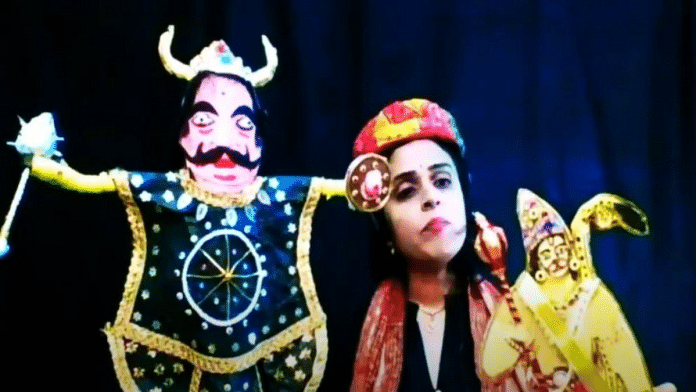In the months following the spectacular hype around the Ram temple in Ayodhya, the enduring Hindu epic Ramayana is going global too.
And this is how the Ramayana was gift-wrapped for Americans: An ancient Indian thriller where Game of Thrones meets The Odyssey.
Nine Indian artistes presented their own creative retelling of Ramayana to over 200 American artistes this month in an online event organised by Hawaiian storyteller and musician Jeff Gere and his Six Feet Apart Productions. Gere handpicked an ensemble of artistes from the Federation of Asian Storytellers (FEAST) and assembled an impressive lineup that showcased a broad spectrum of cultural perspectives and storytelling traditions for his show, ‘Jeff’s Picks – Ramayana’.
It comprised seven acts, each displaying a distinct Asian narrative style. Artistes from various parts of the country added unique elements to the performance. They showcased Indian storytelling traditions ranging from Bharatnatyam to shadow and leather puppetry.
Amalgamation of techniques
From Bengaluru, Ramya Srinidhi introduced the audience to the Japanese storytelling and street theatre technique of ‘Kamishibai’, which uses vividly illustrated boards to bring stories to life. Srinidhi employed artist Rohit Bhasi to create these unique three-dimensional paintings for her act. These renderings offered attendees a glimpse into how Shiva’s bow would have appeared in King Janak’s palace, and how Sita would have looked like while holding a bow more than double her size.
Mumbai’s Sarita Nair exhibited a manner of “storytelling with just hands”. Gere described it as inspired by the intricate gestures practised in the classical Indian dance form of Bharatnatyam. Nair, with her expressive red-painted fingers, took the audience through what Queen Kaikeyi might have said to King Dhasharath to ensure that her son ascended the throne.
Vinita Bhatnagar, a professor from Bhopal, dressed up in red with a beige hat, reciting her part of the story in the ancient ‘Katha’ style. To make it more accessible to foreign literary audiences, she deliberately brought in Miltonic resonances by focusing on how Hanuman rediscovered his own strength and courage. Her poetry was engaging and dramatic, replete with physicality.
Debjani Bhaduri, an artiste based in Chennai, added some variety by starting her mostly English Ramayana recitation with a few lines in Bengali. She cheered for Hanuman, singing his name like one would do in a bhajan (hymn). In an unconventional portrayal, she used scratchy sounds to show how monkeys would have spoken. She also described the magic of Hanuman shrinking to the size of a fly. She was flanked by fellow Chennai-based artiste Ambujavalli Nagarajan, and the duo re-enacted conversations between Ravan and Hanuman.
Meera Venkatesan and Meher Gehi took on the role of journalists in their act, going back in time to report the war between Hanuman’s vanar sena (monkey troops) and Ravan’s army. Venkatesan reported the creation of the Ram Setu bridge and the vanar camp, while Gehi, playing a typical field reporter, fearlessly entered the “lion’s den” in Lanka. They took the audience through the highlights of the war – from its announcement to the dilemma faced by Ravan’s brothers and the intense search for the Sanjeevani booti (herb). “What an invention,” said Gere, praising their ‘reporting’. Venkatesan described Kumbhkaran using what looked like a cardboard cutout from a cartoon showcase. Gehi, on the other hand, dressed up as Sita, emulating her expressions as Gere provided the voiceover for Ram.
Lavanya Srinivas and Ayushi Agrawal told the post-war story, where Ram was ashamed for doubting Sita. They also recreated the famous Bharat-Milap, where King Bharat reunites with his half-brother Ram.
“Netflix shows got nothing on this,” Regina Stoops exclaimed as she and co-producer Claire Hennessy praised the artistes toward the end of the show.
Also read: Urdu Ramayana isn’t a contradiction. Faridabad theatre group shows how
Ramayana for Westerners
This colourful showcase was more reminiscent of a children’s storybook than a Game of Thrones-meets-The Odyssey fantasy. Inspired by Valmiki’s version of the Indian epic, it was a simplified version of the original text that barely scratched the surface. Made for a Western audience and constrained to one hour, it stuck to the most dramatic bits of the story. The artistes mostly spoke in English, enunciating phrases like “I want the golden deer” and “Monkey man Hanuman”. Ravan was reduced to a demon with ten heads in this highly Westernised adaptation of the Ramayana. Moreover, the Indian accent was just as stereotypical as on American TV.
Full of imagery, vivid expressions, 3D models and cardboard cutouts, it was apparent that the show was curated for simple entertainment and artistry.
Jeff Gere: Star of the show
The show saw great performances from several artistes, but all praise was showered on Gere. The organisers were in awe of how well he had shaped the narrative arc of the show.
Gere is a master storyteller, puppeteer, producer, and media artiste. He studied in Milan and San Francisco and has various residencies and international tours to his name. Notably, he was the city and county drama specialist of Honolulu’s Parks Department. Gere has performed across the world since the 1990s, including at the International Storytelling Center. Sharing tales from China, India and beyond, his main focus has always been Hawaii, his homeland. He even represented Hawaii at the Universal Expo in Spain in 1992.
Gere played an instrumental role in organising the show – from bringing in scriptwriters to performing between segments to keep the audience engaged.
If this was an anthology book, Jeff Gere would be its editor. Because he truly was the star of the show.
After their one-sided storytelling session, the makers organised a Zoom after-party to dissect Jeff Gere and his “Indian crew’s” performance. The American audience found the event to be “entertaining” and “informative”. “Loved the creativity,” wrote one audience member on YouTube.
(Edited by Zoya Bhatti)



